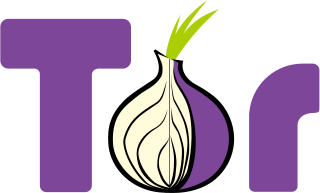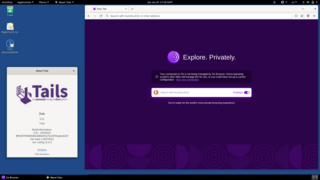
Internet activism, hacktivism, or hactivism, is the use of computer-based techniques such as hacking as a form of civil disobedience to promote a political agenda or social change. With roots in hacker culture and hacker ethics, its ends are often related to free speech, human rights, or freedom of information movements.
An anonymous P2P communication system is a peer-to-peer distributed application in which the nodes, which are used to share resources, or participants are anonymous or pseudonymous. Anonymity of participants is usually achieved by special routing overlay networks that hide the physical location of each node from other participants.

Kevin Lee Poulsen is an American former black-hat hacker and a contributing editor at The Daily Beast.
A dark net or darknet is an overlay network within the Internet that can only be accessed with specific software, configurations, or authorization, and often uses a unique customized communication protocol. Two typical darknet types are social networks, and anonymity proxy networks such as Tor via an anonymized series of connections.

Aaron Hillel Swartz was an American computer programmer, entrepreneur, writer, political organizer, and Internet hacktivist. As a programmer, Swartz helped develop the web feed format RSS; the technical architecture for Creative Commons, an organization dedicated to creating copyright licenses; the website framework web.py; and the lightweight markup language format Markdown. Swartz was involved in the development of the social news aggregation website Reddit until he departed from the company in 2007. He is often credited as a martyr and a prodigy, and his work focused on civic awareness and activism.

Jacob Appelbaum is an American independent journalist, computer security researcher, artist, and hacker.

Tor, short for The Onion Router, is free and open-source software for enabling anonymous communication. It directs Internet traffic via a free, worldwide volunteer overlay network that consists of more than seven thousand relays.

Tails, or "The Amnesic Incognito Live System", is a security-focused Debian-based Linux distribution aimed at preserving Internet privacy and anonymity. It connects to the Internet exclusively through the anonymity network Tor. The system is designed to be booted as a live DVD or live USB and never writes to the hard drive or SSD, leaving no digital footprint on the machine unless explicitly told to do so. It can also be run as a virtual machine, with some additional security risks.
Internet censorship circumvention, also referred to as going over the wall or scientific browsing in China, is the use of various methods and tools to bypass internet censorship.
GlobaLeaks is an open-source, free software intended to enable secure and anonymous whistleblowing initiatives.
The Associated Whistleblowing Press (AWP) is a not-for-profit information agency based in Brussels, Belgium, dedicated to the defense of human rights by promoting transparency, freedom of information and speech, whistleblowing and investigative journalism, conceived as a global network made up of cooperative local platforms and actors. According to its website, the initiative aims to work in a decentralized network structure, with local platforms that deal with local information, contexts and actors in a "from the roots upward model". The stories produced will then be published on the project's multilanguage newsroom under a Creative Commons license. The team consists of collaborators spread all around the world, led by two editors, Pedro Noel and Santiago Carrion.
Freedom of the Press Foundation (FPF) is a non-profit organization founded in 2012 to fund and support free speech and freedom of the press. The organization originally managed crowd-funding campaigns for independent journalistic organizations, but now pursues technical projects to support journalists' digital security and conducts legal advocacy for journalists.

Tor2web is a software project to allow Tor hidden services to be accessed from a standard browser without being connected to the Tor network. It was created by Aaron Swartz and Virgil Griffith.

The Tor Project, Inc. is a 501(c)(3) research-education nonprofit organization based in Winchester, New Hampshire. It is founded by computer scientists Roger Dingledine, Nick Mathewson, and five others. The Tor Project is primarily responsible for maintaining software for the Tor anonymity network.

Roger Dingledine is an American computer scientist known for having co-founded the Tor Project. A student of mathematics, computer science, and electrical engineering, Dingledine is also known by the pseudonym arma. As of December 2016, he continues in a leadership role with the Tor Project, as a project Leader, Director, and Research Director.
Cure53 is a German cybersecurity firm. The company was founded by Dr. Mario Heiderich, a security researcher.

Truth & Transparency Foundation was a whistleblowing organization inspired by WikiLeaks, which focused on exposing documents from the leadership of the Church of Jesus Christ of Latter-day Saints. Founded in December 2016 and ceasing operations in April 2022, Truth & Transparency was a nonprofit newsroom dedicated to religious accountability through impact journalism.
James S. Dolan was an American computer security expert who, with Aaron Swartz and Kevin Poulsen, co-developed SecureDrop, a widely used secure digital platform for sources to anonymously submit materials to journalists.

Runa Sandvik is a Norwegian-American computer security expert and founder of Granitt. She is noted for her extensive work in protecting at-risk civil society groups, including human rights defenders, lawyers, and journalists. Sandvik was previously the Senior Director of Information Security at The New York Times, helping launch the company’s confidential tips page in December 2016.










